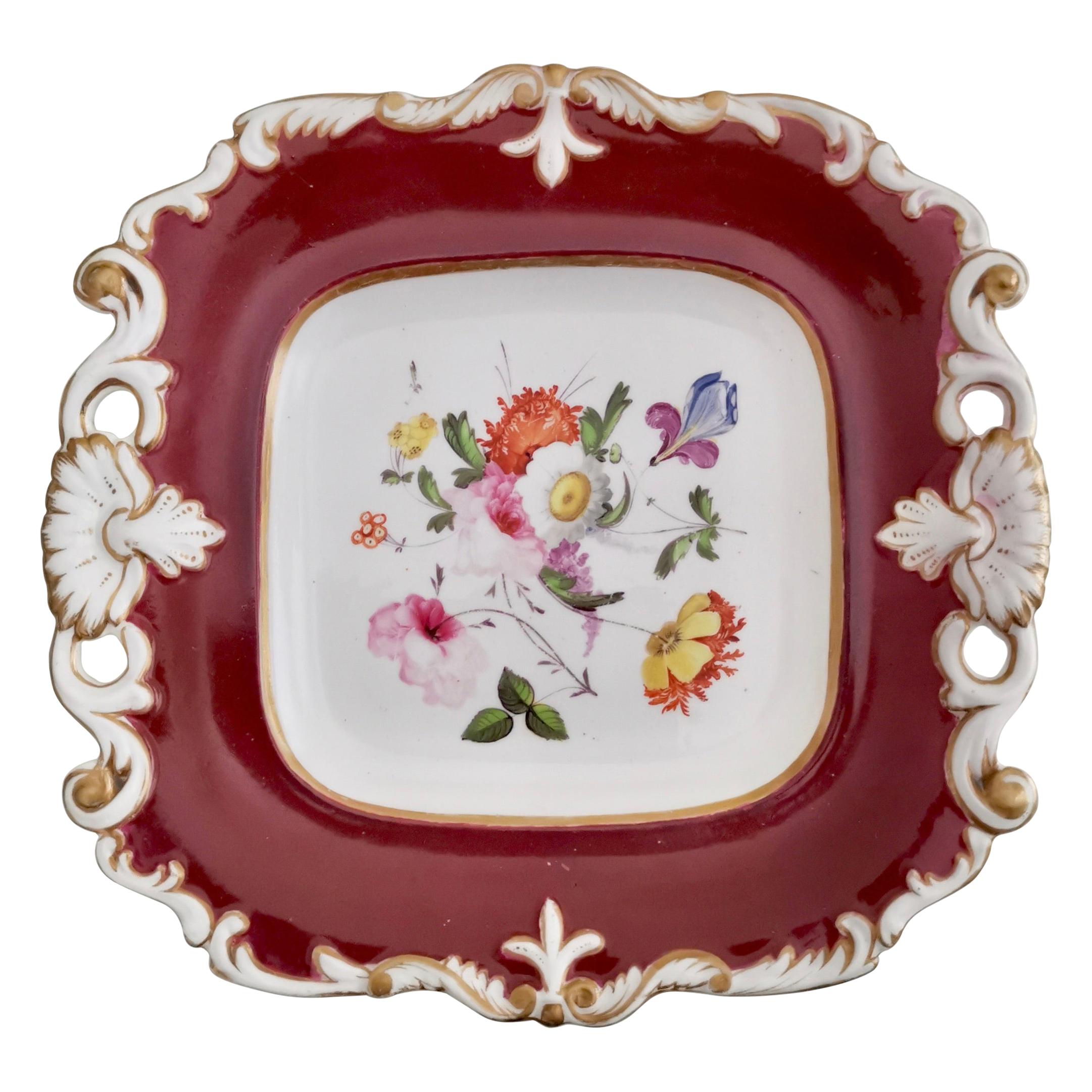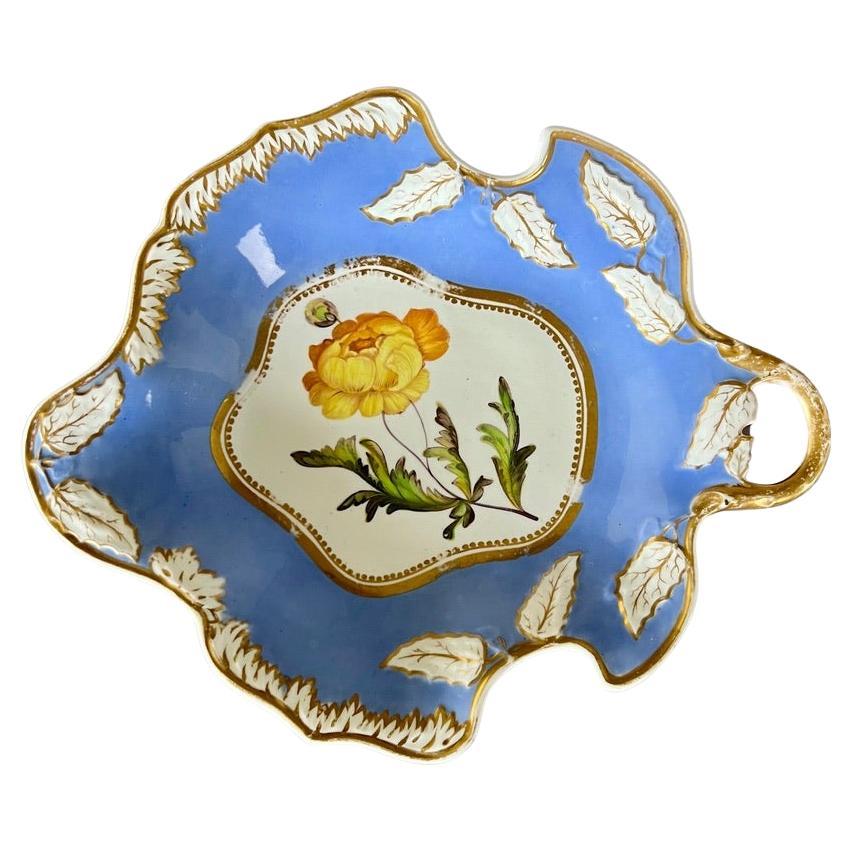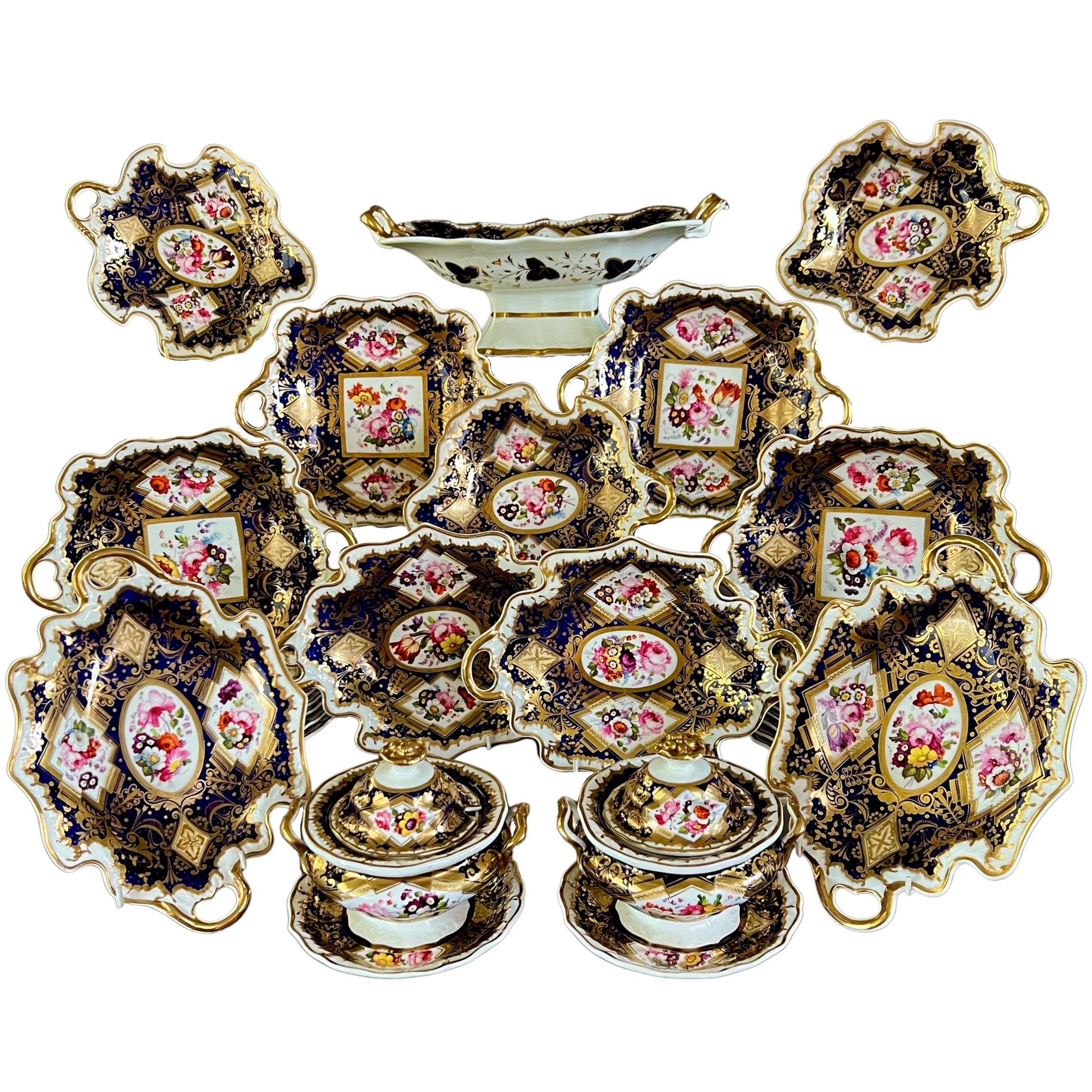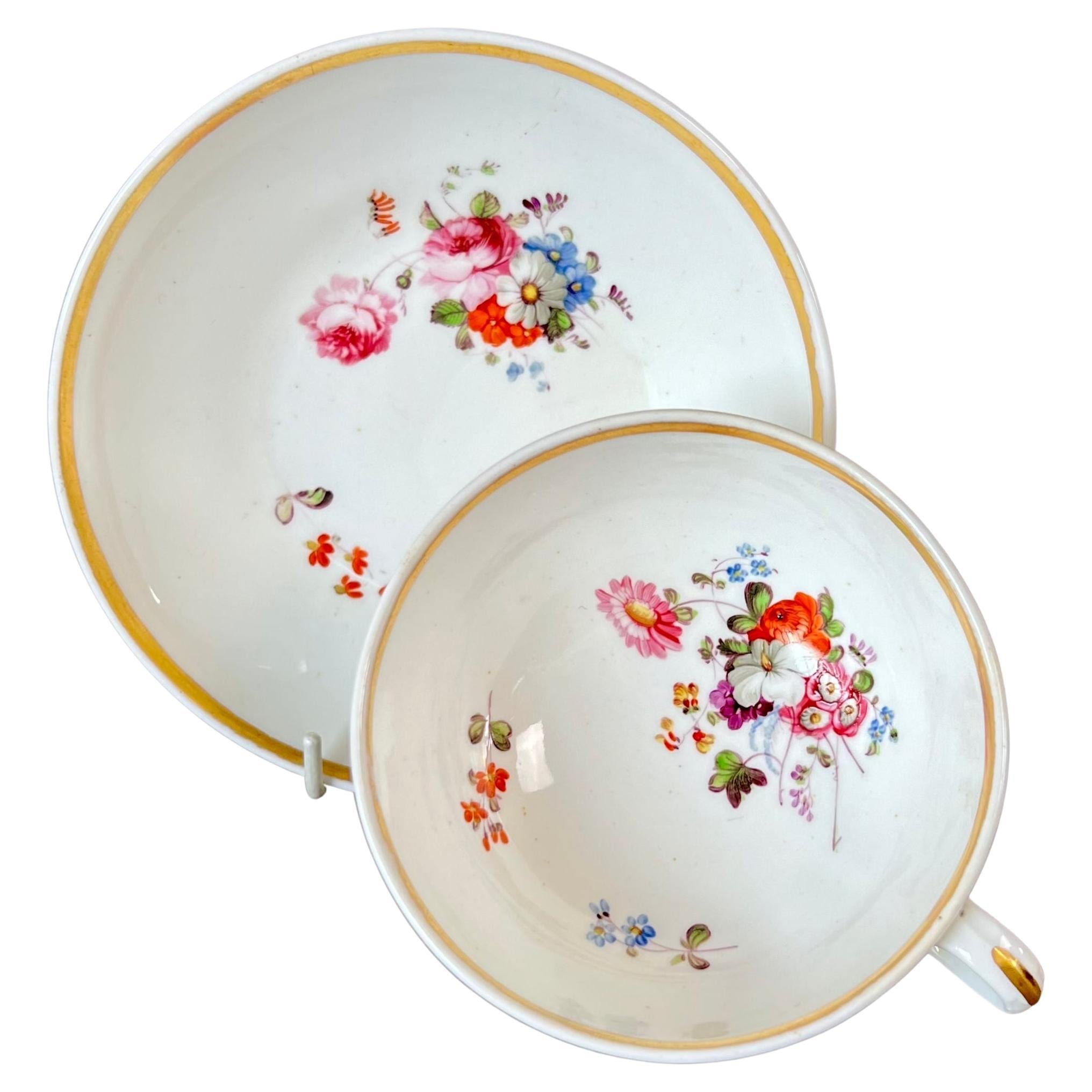Items Similar to Samuel Alcock Plate, Inverted Shell, Flowers, Provenance G.A.Godden Regency 1822
Want more images or videos?
Request additional images or videos from the seller
1 of 13
Samuel Alcock Plate, Inverted Shell, Flowers, Provenance G.A.Godden Regency 1822
About the Item
This is a very striking and rare square dessert serving dish made by Samuel Alcock, circa 1822. The dish has a hand painted flower landscape in an unusual style. The dish has provenance; it came from the Reference collection of Geoffrey A. Godden, the famous porcelain historian
This dish would have been part of a large dessert service.
The Samuel Alcock factory was operative in Staffordshire between 1822 and 1856, after which it was bought by Sir James Duke and Nephews. The factory started as a partnership between the young Samuel Alcock and the older Ralph Stevenson, who provided the factory and capital. Alcock quickly took the factory to great heights, building one of the biggest factories of its time. Alcock jumped on the new Rococo Revival fashion and served a huge new middle class market. The reason we now don't hear much about Samuel Alcock porcelain is that much of it has been mis-identified over the years and attributed to Coalport, Ridgway, Rockingham or others; Alcock did not mark any of his porcelain save a few rare pieces, and the numbering system is difficult to understand. However, the wares are still wide spread and many are of great quality.
This dish has a wonderful moulded rim with piercings and shell details; this is often called the "inverted shell" shape. The rims are gilded with a pattern of fine vines. The centre decoration consists of an intriguing flower painting that is slightly naive and very unusual; it doesn't only show beautiful bright flowers against a hazy background of hills, it also shows the roots under the ground.
This shape was produced by various factories, among which were Minton, New Hall and Hicks & Meigh. We know from the pattern number and the style of the image that this one was made by Samuel Alcock.
The dish is unmarked except the pattern number 547 and a label from the Geoffrey A. Godden reference collection. The pattern number points to the year 1822.
Condition report: The dish is in excellent condition without any damage or repairs, but it is crazed as visible in some of the pictures. There is very little wear.
Antique British porcelain is never perfect. Kilns were fired on coal in the 1800s, and this meant that china from that period can have some firing specks from flying particles. British makers were also known for their experimentation, and sometimes this resulted in technically imperfect results. Due to the shrinkage in the kiln, items can have small firing lines or develop crazing over time, which should not be seen as damage but as an imperfection of the maker's recipes, probably unknown at the time of making. Items have often been used for many years and can have normal signs of wear, and gilt can have signs of slight disintegration even if never handled. I will reflect any damage, repairs, obvious stress marks, crazing or heavy wear in the item description but some minor scratches, nicks, stains and gilt disintegration can be normal for vintage items and need to be taken into account.
There is widespread confusion on the internet about the difference between chips and nicks, or hairlines and cracks. I will reflect any damage as truthfully as I can, i.e. a nick is a tiny bit of damage smaller than 1mm and a chip is something you can easily see with the eye; a glazing line is a break in the glazing only; hairline is extremely tight and/or superficial and not picked up by the finger; and a crack is obvious both to the eye and the finger.
Dimensions: 21.5cm (8.5") x 20.5cm (8").
- Creator:Samuel Alcock & Co. (Maker)
- Dimensions:Height: 1 in (2.54 cm)Width: 8.5 in (21.59 cm)Depth: 8 in (20.32 cm)
- Style:Regency (Of the Period)
- Materials and Techniques:
- Place of Origin:
- Period:
- Date of Manufacture:1822
- Condition:Wear consistent with age and use. In excellent antique condition, no damage or repairs, some crazing and very little wear.
- Seller Location:London, GB
- Reference Number:
About the Seller
5.0
Platinum Seller
These expertly vetted sellers are 1stDibs' most experienced sellers and are rated highest by our customers.
Established in 2016
1stDibs seller since 2019
208 sales on 1stDibs
Typical response time: <1 hour
- ShippingRetrieving quote...Ships From: London, United Kingdom
- Return PolicyA return for this item may be initiated within 14 days of delivery.
More From This SellerView All
- Samuel Alcock Plate, Melted Snow Border, Periwinkle Blue Lilac, Flowers, ca 1822By Samuel Alcock & Co.Located in London, GBA plate with white melted snow border on a periwinkle ground with tiny gilt stars, with a beautifully painted flower bouquet in the centre There are several other items available in...Category
Antique 1820s English Regency Dinner Plates
MaterialsPorcelain
- Samuel Alcock Porcelain Plate, Maroon with Flowers, Regency, ca 1825By Samuel Alcock & Co.Located in London, GBThis is a very striking and rare dessert plate made by Samuel Alcock around the year 1825. The plate is square and has the "inverted shell" moulding with pierced borders, a deep maro...Category
Antique 1820s English Regency Dinner Plates
MaterialsPorcelain
- Samuel Alcock Footed Comport, Melted Snow, Periwinkle Lilac, Flowers, ca 1822By Samuel Alcock & Co.Located in London, GBA footed rectangular central comport or centre piece, periwinkle / lilac ground with melted snow and holly leaf borders and flowers, a large pink wild rose painting in the centre Th...Category
Antique 1820s English Regency Serving Bowls
MaterialsPorcelain
- Samuel Alcock Porcelain Leaf Dish, Periwinkle Blue with Yellow Flower, ca 1822By Samuel Alcock & Co.Located in London, GBA one-handled leaf dish with white melted snow and holly leaf border on a periwinkle ground, and a beautiful flower study of a yellow ranunculus in the centre There are several other items available in near-identical style, see separate listings. Pattern 507 Year: ca 1822 Size: 26cm X 21.5cm (10.25” X 8.5”) Condition: some rubbing The Samuel Alcock factory was operative in Staffordshire between 1822 and 1856, after which it was bought by Sir James Duke and Nephews. The factory started as a partnership between the young Samuel Alcock and the older Ralph Stevenson, who provided the factory and capital. Alcock quickly took the factory to great heights, building one of the biggest factories of its time. Alcock jumped on the new Rococo Revival fashion and served a huge new middle class market. The reason we now don't hear much about Samuel Alcock porcelain...Category
Antique 1820s English Regency Serving Bowls
MaterialsPorcelain
- Samuel Alcock Dessert Service for 12, Cobalt Blue, Gilt and Flowers ca 1822By Samuel Alcock & Co.Located in London, GBA magnificent large complete dessert service consisting of a high footed centre piece, four rectangular dishes, four oval dishes, three leaf dishes, two sauce tureens with covers and...Category
Antique 1820s English Regency Dinner Plates
MaterialsPorcelain
- Samuel Alcock Porcelain Teacup, White with Flower Sprays, ca 1823By Samuel Alcock & Co.Located in London, GBA teacup and saucer in the “half orange” shape, white with simple gilt rim and beautiful hand painted flower sprays Pattern unknown but similar to 1082 Year: ca 1823 Size: cup diameter 10cm (4”), saucer diameter 14.2cm (5.5”) Condition: excellent, some rubbing to gilt There are several items available in this design, please see group image and ask for more info if interested. The Samuel Alcock factory was operative in Staffordshire between 1822 and 1856, after which it was bought by Sir James Duke and Nephews. The factory started as a partnership between the young Samuel Alcock and the older Ralph Stevenson, who provided the factory and capital. Alcock quickly took the factory to great heights, building one of the biggest factories of its time. Alcock jumped on the new Rococo Revival fashion and served a huge new middle class market. The reason we now don't hear much about Samuel Alcock porcelain...Category
Antique 1820s English Regency Tea Sets
MaterialsPorcelain
You May Also Like
- Samuel Alcock & Co Palissy Majolica Geranium Floral Shallow Bowl, circa 1850By Samuel Alcock & Co.Located in Philadelphia, PAAn unusual Royal Palissy line Geranium Floral oval bowl, from Samuel Alcock & Co, Burslem, Staffordshire, England, circa 1850. This is a scarce example of Alcocks Palissy Geranium...Category
Antique Mid-19th Century English Aesthetic Movement Platters and Serveware
MaterialsEarthenware
- Samuel Alcock & Co. Majolica Strawberry & Grape Cluster Dessert Tray, circa 1850By Samuel Alcock & Co.Located in Philadelphia, PAA majolica glazed handled and footed tray from Samuel Alcock & Co, Burslem, Staffordshire, England, circa 1850. A strawberry, grape cluster, floral and leaf motif on a shaped tray...Category
Antique Mid-19th Century English Aesthetic Movement Platters and Serveware
MaterialsEarthenware
- A fine English porcelain Punch Bowl attributed to Samuel Alcock c.1830By Samuel Alcock & Co.Located in Exeter, GBA fine English porcelain Punch Bowl attributed to Samuel Alcock c.1830. Superbly painted summer flowers to the centre interior of the bowl...Category
Antique 19th Century Porcelain
MaterialsPorcelain
- Samuel Alcock & Co Majolica Strawberry Leaf Form Dessert Tray England circa 1850By Samuel Alcock & Co.Located in Philadelphia, PAA majolica glazed leaf form dessert tray from Samuel Alcock & Co, Burslem, Staffordshire, England, circa 1850. A central strawberry leaf on a shaped tray with a vine border, and sho...Category
Antique Mid-19th Century English Aesthetic Movement Platters and Serveware
MaterialsEarthenware
- Samuel Alcock & Co Majolica Strawberry Leaf Form Dessert Tray England circa 1850By Samuel Alcock & Co.Located in Philadelphia, PAA majolica glazed leaf form dessert tray from Samuel Alcock & Co, Burslem, Staffordshire, England, circa 1850. A central strawberry leaf on a shaped tray with a vine border, and sho...Category
Antique Mid-19th Century English Aesthetic Movement Platters and Serveware
MaterialsEarthenware
- 2 Antique 19th Century English Samuel Alcock Blue Gold Floral Cups & SaucersBy Samuel Alcock & Co.Located in Dayton, OH"Four piece set of antique mid 19th century Samuel Alcock porcelain tea / coffee cups and saucers featuring turquoise blue with florals and gold gilding. Samuel Alcock (1799–1848) was a leading pottery manufacturer who operated as Samuel Alcock & Co in Burslem, Staffordshire from 1828 to 1859. They were especially noted for ""picture jugs"" modelled and moulded in relief in various ceramic materials, a popular type of object in these years. Samuel Alcock & Co. Alcock was born in Kingsley, Staffordshire. He was the youngest of the nine children of Thomas (1746–1816) and Catherine Alcock (1756–1838). Though from a farming background, he developed an interest in commerce after working with his uncle Joseph Locker, a grocer, tea dealer, provision dealer, chandler and banker of the Market Square, Hanley. His introduction to pottery came when he embarked upon a partnership with Ralph Stevenson of Cobridge, Staffordshire. In 1828, Alcock developed his own business and began work on the Hill Top site in Cobridge. By the 1830s Stevenson employed 600 people at his works. In 1839 he completed work on a large factory, built in the Venetian style, on the junction of Westport Road and Greenhead Street. In November of that year a party to celebrate the opening was held at the George Hotel...Category
Antique 19th Century Victorian Tea Sets
MaterialsPorcelain
Recently Viewed
View AllMore Ways To Browse
Porcelain Dish
Vintage Antique Flowers
Antique Porcelain Dish
Flower Dish
Flowers Never Seen
Vintage Serveware By England
British Regency
Regency Glass Flower
Stained Glass Flowers
Stained Glass With Flowers
Circa 1820 Painting
Stained Glass Artist
Rare Stained Glass
Painted And Fired Stained Glass
Silver Gilt Shell
Porcelain E Silver Antique
Regency Hand Painted Porcelain
Antique Porcelain Service





